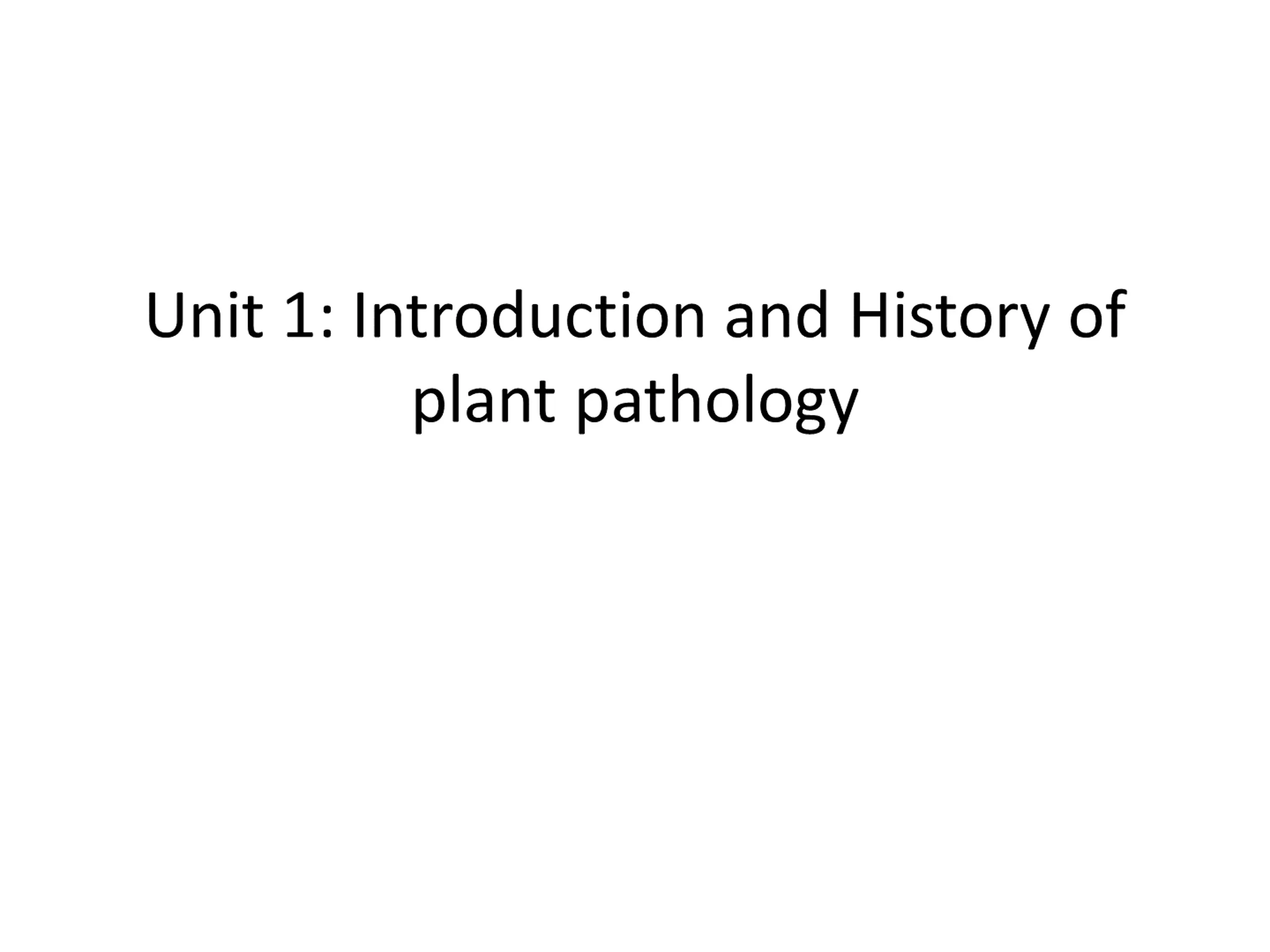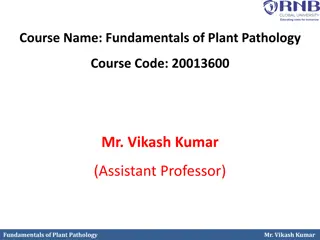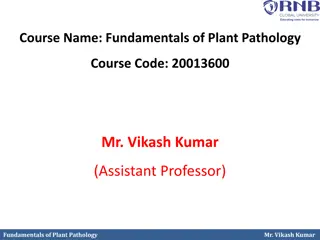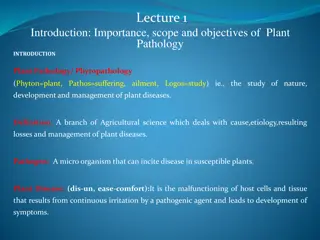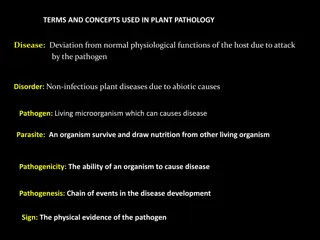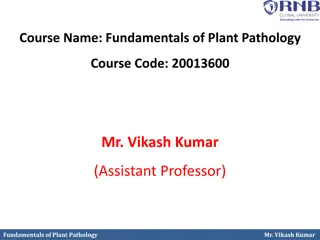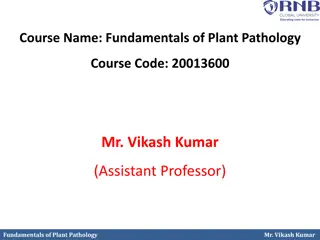Unit 1: Introduction and History of plant pathology
The science of plant pathology, which studies plant diseases and aims to protect the food supply by improving plant survival in unfavorable conditions. Explore the causes of plant diseases, their symptoms, and methods of prevention and control.
Download Presentation

Please find below an Image/Link to download the presentation.
The content on the website is provided AS IS for your information and personal use only. It may not be sold, licensed, or shared on other websites without obtaining consent from the author.If you encounter any issues during the download, it is possible that the publisher has removed the file from their server.
You are allowed to download the files provided on this website for personal or commercial use, subject to the condition that they are used lawfully. All files are the property of their respective owners.
The content on the website is provided AS IS for your information and personal use only. It may not be sold, licensed, or shared on other websites without obtaining consent from the author.
E N D
Presentation Transcript
Unit 1: Introduction and History of plant pathology
Plant Pathology Plant pathology is a science that studies plant diseases and attempts to improve the chances for survival of plants when they are faced with unfavorable environmental conditions and parasitic microorganisms that cause disease. Plant pathology is challenging, interesting, important, and worth studying in its own right. It is also, however, a science that has a practical and noble goal of protecting the food available for humans and animals. It is also, however, a science that has a practical and noble goal of protecting the food available for humans and animals. Plant diseases, by their presence, prevent the cultivation and growth of food plants in some areas; or food plants may be cultivated and grown but plant diseases may attack them, destroy parts or all of the plants, and reduce much of their produce, i.e., food, before they can be harvested or consumed. In the pursuit of its goal, plant pathology is joined by the sciences of entomology and weed science.
Plants and Disease Plants, whether cultivated or wild, grow and produce well as long as the soil provides them with sufficient nutrients and moisture, sufficient light reaches their leaves, and the temperature remains within a certain normal range. Plants, however, also get sick. Sick plants grow and produce poorly, they exhibit various types of symptoms, and, often, parts of plants or whole plants die. It is not known whether diseased plants feel pain or discomfort. The agents that cause disease in plants are the same or very similar to those causing disease in humans and animals. They include pathogenic microorganisms, such as viruses, bacteria, fungi, protozoa, and nematodes, and unfavorable environmental conditions, such as lack or excess of nutrients, moisture, and light, and the presence of toxic chemicals in air or soil. Plant damage caused by insects, humans, or other animals is not usually included in the study of plant pathology. Plant pathology is the study of the organisms and of the environmental factors that cause disease in plants; of the mechanisms by which these factors induce disease in plants; and of the methods of preventing or controlling disease and reducing the damage it causes. Plant pathology is an integrative science and profession that uses and combines the basic knowledge of botany, mycology, bacteriology, virology, nematology, plant anatomy, plant physiology, molecular biology engineering, biochemistry, horticulture, agronomy, tissue culture, soil science, forestry, chemistry, physics, meteorology, and many other branches of science. genetics, genetic and
The concept of disease It is accepted that a plant is healthy, or normal, when it can carry out its functions to the best of its genetic potential. meristematic (cambium) cells of a healthy plant divide and differentiate as needed, and different types of specialized cells absorb nutrients from translocate these to all plant parts; carry on photosynthesis, translocate, metabolize, store the products; and produce seed or other reproductive organs for survival and multiplication. When the ability of the cells of a plant or plant part to carry out one or more of these essential interfered with by either a pathogenic organism or an adverse environmental factor, the activities of the cells are disrupted, altered, or inhibited, the cells malfunction or die, and the plant becomes diseased. Disease in plants, then, can be defined as the series of invisible and visible responses of plant cells and tissues to a pathogenic organism or environmental factor that result in adverse changes in the form, function, or integrity of the plant and may lead to partial impairment or death of plant parts or of the entire plant. physiological functions is The water the and soil; or photosynthetic
For example, infection of roots may cause roots to rot and make them unable to absorb water and nutrients from the soil; infection of xylem vessels, as happens in vascular wilts and in some cankers, interferes with the translocation of water and minerals to the crown of the plant; infection of the foliage, as happens in leaf spots, blights, rusts, mildews, mosaics, and so on, interferes with photosynthesis; infection of phloem cells in the veins of leaves and in the bark of stems and shoots, as happens in cankers and in diseases caused by viruses, mollicutes, and protozoa, interferes with the downward photosynthetic products; and infection of flowers and fruits interferes with reproduction. translocation of
Pathogenic microorganisms, i.e., the transmissible biotic (= living) agents that can cause disease and are generally referred to as pathogens, usually cause disease in plants by disturbing the metabolism of plant cells through enzymes, toxins, growth regulators, and other substances they secrete and by absorbing foodstuffs from the host cells for their own use. Some pathogens may also cause disease by growing and multiplying in the xylem or phloem vessels of plants, thereby blocking the upward transportation of water or the downward movement of sugars, respectively, through these tissues. Environmental factors cause disease in plants when abiotic factors, such as temperature, moisture, mineral nutrients, and pollutants, occur at levels above or below a certain range tolerated by the plants.
Types of plant diseases Plant diseases are sometimes grouped according to the symptoms they cause (root rots, wilts, leaf spots, blights, rusts, smuts), to the plant organ they affect (root diseases, stem diseases, foliage diseases), or to the types of plants affected (field crop diseases, vegetable diseases, turf diseases, etc.). One useful criterion for grouping diseases is the type of pathogen that causes the disease. The advantage of such a grouping is that it indicates the cause of the disease, which immediately suggests the probable development and spread of the disease and also possible control measures.
Types of plant diseases On this basis, plant diseases are classified as follows:
